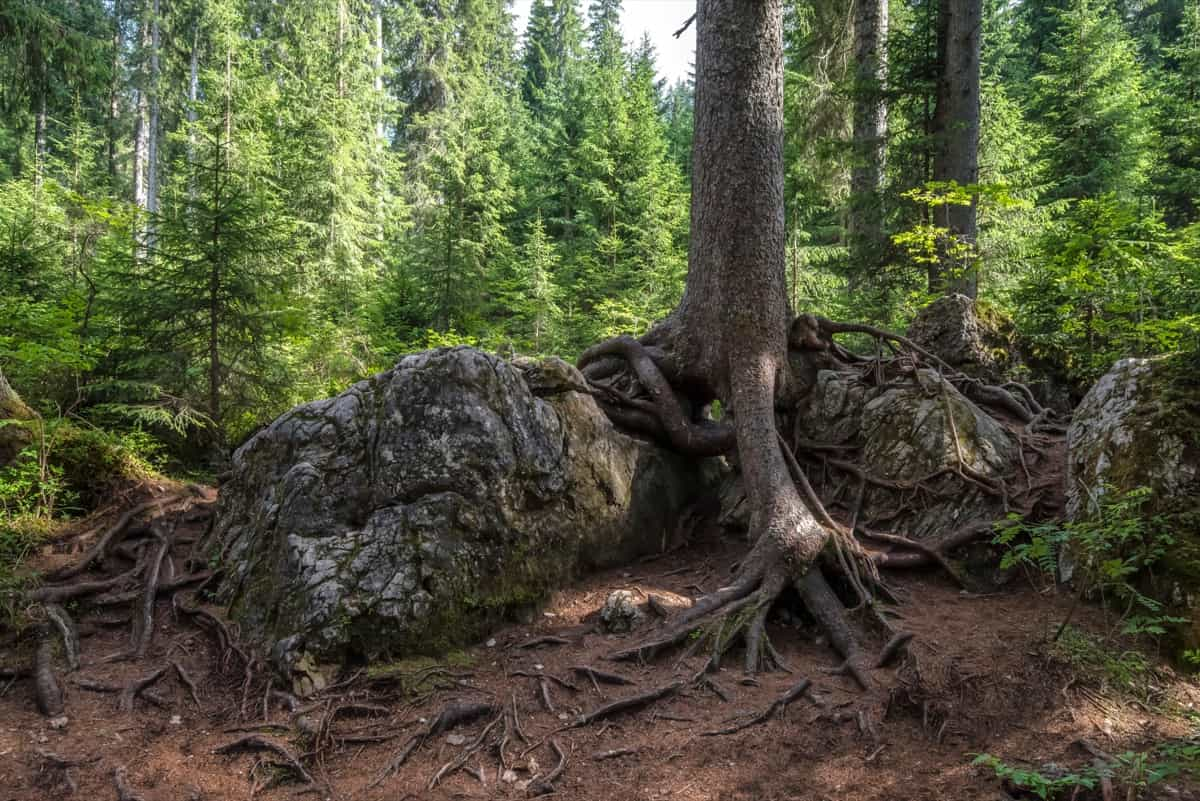Dealing with tree roots that are above ground can be challenging, especially if exposed to oak tree roots. Many homeowners ponder, “How do you deal with exposed roots?” or “What can you do with tree roots above ground?”. There are effective steps to mitigate the situation for those dealing with exposed roots.

This article covers these steps in detail, ensuring you can carefully and successfully navigate through problems like cutting tree roots without killing the tree, working around trees with exposed roots, and determining what kills tree roots quickly if necessary.
Understanding the Causes of Exposed Tree Roots
Exposed tree roots often occur due to erosion, compacted soil, or lawn mowing that removes the top layer of soil. Understanding these causes is crucial to identifying the best way to remove roots from the ground if they become problematic. Erosion washes away the soil covering roots, while compacted soil makes it hard for roots to expand downward, forcing them to grow sideways and sometimes above the ground.
Regular lawn mowing can unintentionally remove the soil, exposing the roots over time. Trees positioned on a slope are also more likely to have their roots exposed due to the continuous movement of soil downhill.
Assessing the Impact of Exposed Tree Roots on Tree Health
Evaluating the health impact of exposed roots on trees is vital before action. Roots above ground can imply various issues like stress, which might affect the tree’s overall health and longevity. For instance, a tree with roots exposed for a long time might have difficulty absorbing nutrients and water, making it more susceptible to diseases and adverse weather conditions. Before considering any radical solution, like finding what kills tree roots quickly, you must assess the exposed roots’ impact on the tree’s health to make informed decisions on managing them.
8 Steps to Deal with Exposed Tree Roots
Step 1: Identifying the Type of Tree and Its Root System
The first step in dealing with tree roots is identifying the type of tree and understanding its root system. Different trees have different types of roots. For instance, an oak tree is root system differs from that of other trees, and the method used for dealing with exposed oak tree roots may not be applicable to others. Some trees have roots that naturally grow close to the soil surface, while others have deep root systems. Identifying the type of tree will help you decide whether to cover tree roots with soil or choose another appropriate method to deal with the exposed roots.
Step 2: Evaluating the Severity of Root Exposure
To address exposed roots adequately, you must evaluate the severity of root exposure. If only a small portion of the roots is showing, the risk to the tree is minimal, and simple solutions like planting around the tree with exposed roots can be effective. However, if a large portion of the roots is exposed, it may pose a significant risk to the tree’s stability and health. In this case, you might need to explore various options, including professional advice, before deciding whether shaving or cutting the tree roots is necessary without harming the tree.
Step 3: Determining the Potential Risks and Hazards
Finally, before taking any action, it’s essential to determine the potential risks and hazards associated with exposed tree roots. Exposed roots can be a tripping hazard, making areas around them unsafe. Moreover, roots compete with other plants for nutrients and water, potentially negatively impacting the surrounding vegetation’s health.
By identifying these risks, you can decide whether to remove, shave, or cover the exposed tree roots with soil, ensuring that you take the most appropriate and safe action for the tree and the surrounding environment. Understanding the potential risks will guide you in dealing with tree roots effectively and safely.
Step 4: Implementing Proper Watering Techniques
When managing exposed tree roots, watering appropriately can make a significant difference. Overwatering or underwatering can exacerbate the exposure of roots. By ensuring the tree receives consistent and deep watering, the roots will be encouraged to grow downwards, reducing their chances of spreading outwards and above the ground.
In case you missed it: How to Graft an Avocado Tree: Rootstock Used, Techniques, and Methods

Watering deeply ensures that the moisture reaches the deeper roots, thus keeping them nourished and reducing the need for them to surface. It’s advisable to water trees early in the morning or late in the afternoon to reduce evaporation, ensuring the tree gets the maximum benefit from each watering session.
Step 5: Applying Mulch to Protect Exposed Roots
Mulch serves as an excellent solution to protect and cover exposed tree roots. You can protect the tree’s roots from the sun, save water, and stop soil from washing away by putting a thick layer of natural mulch like wood chips or compost around the tree. Mulch also helps moderate soil temperature, ensuring the roots remain in a conducive environment for growth. Furthermore, as the mulch breaks down over time, it provides additional nutrients to the tree and improves the soil’s structure, making it beneficial for the tree and the surrounding plants.
Step 6: Pruning and Trimming Exposed Roots
In some cases, pruning or trimming the exposed roots might be necessary. However, this should be done with caution. Before cutting any root, it’s crucial to understand that removing large roots can destabilize the tree and harm its health. When you decide to prune, ensure you’re cutting smaller roots, not more than two inches in diameter. Always use sharp and sterilized tools to make clean cuts, reducing the chances of infection. After pruning, it’s a good practice to cover the area with soil or mulch to protect the remaining roots and promote healing.
Step 7: Installing Root Barriers or Retaining Walls
Root barriers and retaining walls can effectively prevent roots from surfacing, especially in areas where they might interfere with structures or pavements. Root barriers are usually made of plastic or metal and are buried vertically to redirect the roots deeper into the ground. Retaining walls, on the other hand, can help hold the soil in place, especially in sloped areas, thus preventing erosion and subsequent root exposure. When installing either of these, care should be taken not to damage the existing roots or impede the tree’s natural growth.
Step 8: Seeking Professional Help for Tree Root Management
While many of the steps mentioned can be undertaken as DIY projects, there might be situations where seeking professional help becomes essential. An arborist or tree care professional can provide expert advice on managing exposed roots, ensuring the tree’s health and stability aren’t compromised.
They can assess the situation, recommend specific actions tailored to the tree type and root system, and even perform complex procedures like root pruning with precision. Seeking professional help ensures that you’re taking the best care of your tree while dealing with the challenges exposed roots pose.
In case you missed it: How to Graft a Lemon Tree: Rootstock Used, Best Time to Graft, Techniques, and Methods

Conclusion
Trees, with their vast canopies and rooted presence, play a pivotal role in enhancing our environment’s beauty and ecological balance. However, it’s vital to approach the situation with knowledge and care when faced with the issue of exposed roots. From understanding the cause behind the surfacing roots to implementing measures such as proper watering, mulching, and even seeking professional help, each step ensures the tree’s longevity and health are not compromised.
- Feed Your Flock for Less: Top 10 Tips to Save on Chicken Feed
- Ultimate Guide to Ossabaw Island Hog: Breeding, Raising, Diet, and Care
- Hatching Answers: The Top 10 Reasons Your Chickens Aren’t Laying Eggs
- Eggs and Economics: Breaking Down the Cost of Raising Backyard Chickens
- Defend Your Greens: Proven Methods to Keep Iguanas Out of Your Garden
- Ultimate Guide to Cinnamon Queen Chicken: A Comprehensive Guide for Beginners
- Ultimate Guide to California Tan Chicken: Breeding, Raising, Diet, Egg-Production and Care
- Ultimate Guide to Marsh Daisy Chicken: Breeding, Raising, Diet, and Care
- 10 Types of Chicken Farming Businesses You Can Start for Profits